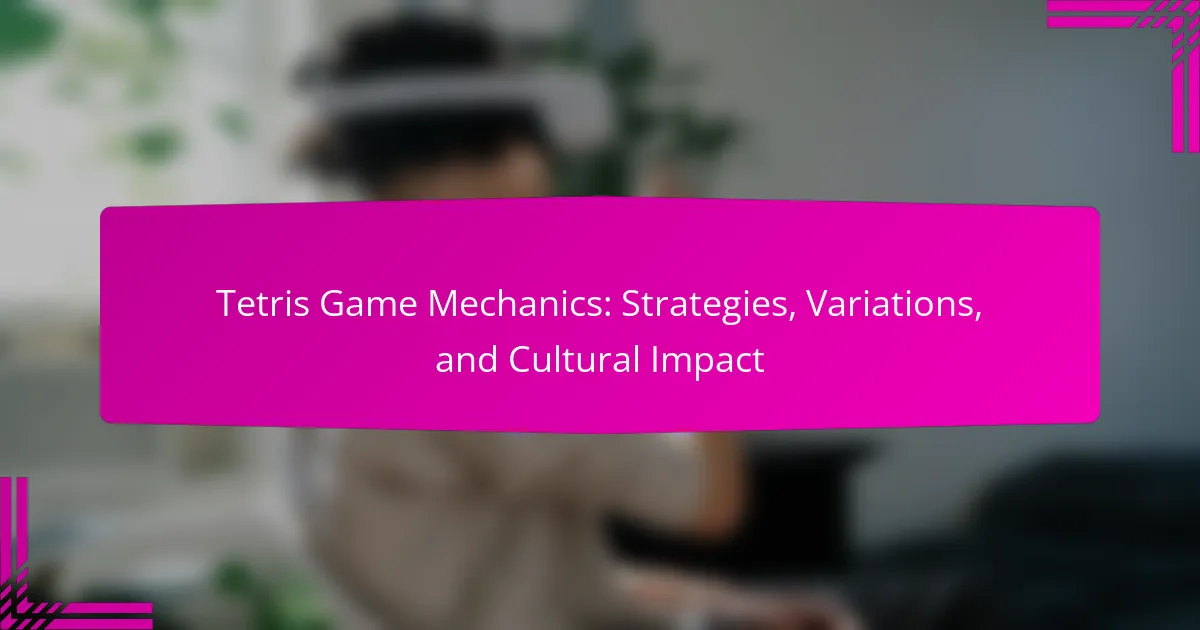Tetris offers players a unique challenge that sharpens cognitive skills and enhances problem-solving abilities. This article explores core game mechanics, effective strategies for improvement, various game variations, and the cultural impact of Tetris. Discover how mastering techniques like T-spins can elevate your gameplay while understanding the game’s influence on competitive play and media.
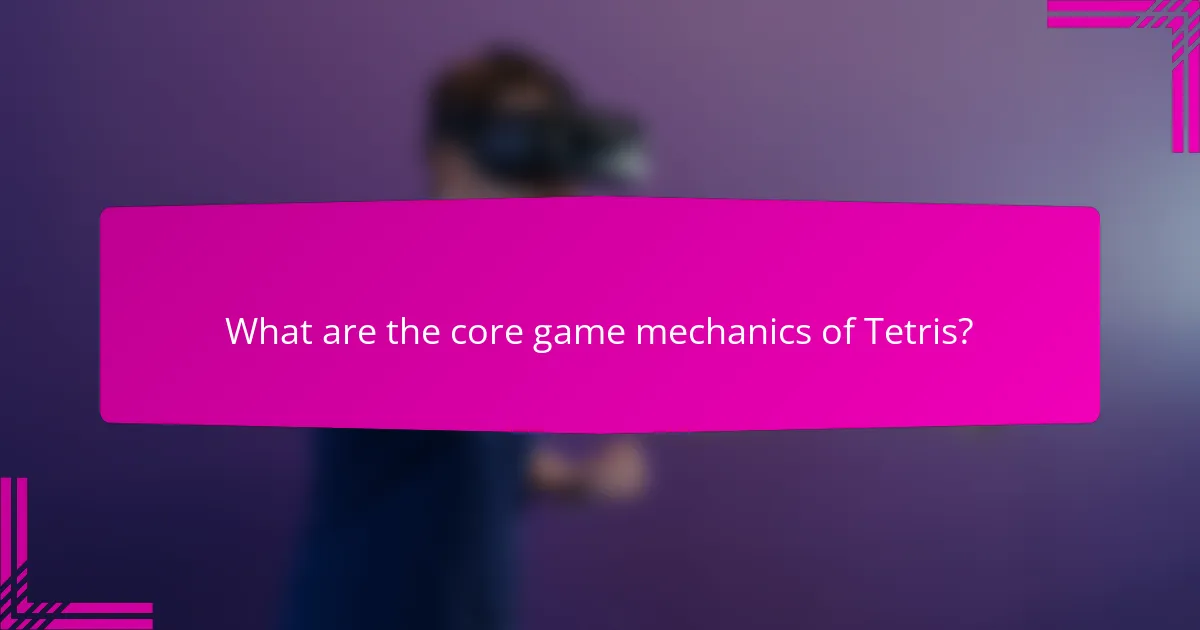
What are the core game mechanics of Tetris?
Tetris features core game mechanics that include shape manipulation, line clearing, and scoring strategies. Players rotate and place tetrominoes to form complete lines, which then disappear. The game accelerates as levels increase, challenging players to adapt quickly. Variations like multiplayer modes and themed versions expand its cultural impact, making Tetris a timeless classic.
How do Tetris pieces interact with the game grid?
Tetris pieces, or tetrominoes, interact with the game grid by fitting into available spaces and clearing lines. Each piece rotates and can be placed to create complete horizontal lines, which then disappear, awarding points. The game mechanics rely on spatial reasoning, as players must anticipate how pieces will fall and fit together. Unique attributes include the distinct shapes of each tetromino, which influence strategy. As the game progresses, the speed increases, adding a layer of challenge to piece placement and line clearing.
What is the significance of line clearing in Tetris?
Line clearing in Tetris is significant as it directly impacts game progression and player strategy. Clearing lines earns points, increases speed, and can create opportunities for combo chains. This mechanic encourages players to think critically about piece placement and anticipate future moves. Successfully clearing multiple lines at once, known as a Tetris, yields higher scores and enhances gameplay satisfaction.
How does gravity affect piece placement in Tetris?
Gravity in Tetris causes pieces to fall vertically, influencing player strategy for optimal placement. As blocks descend, players must quickly assess the available space to position pieces effectively. This dynamic adds urgency, requiring quick decision-making to prevent game over. Mastery of gravity mechanics enhances overall gameplay and allows for advanced techniques, such as stacking and creating Tetrises.
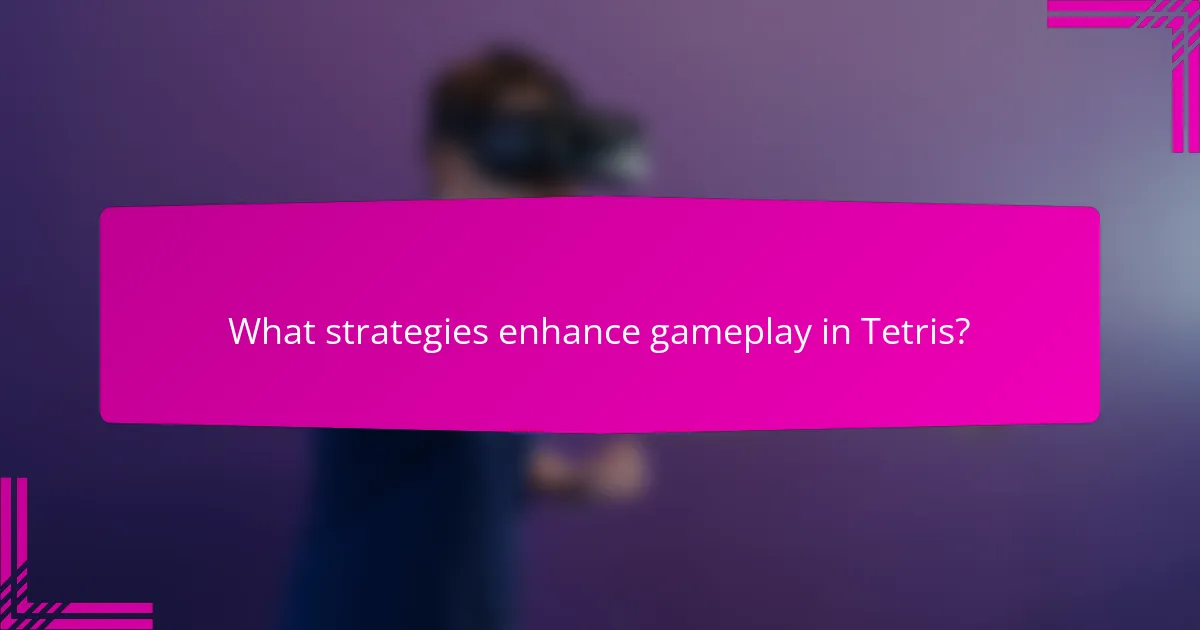
What strategies enhance gameplay in Tetris?
To enhance gameplay in Tetris, players should focus on several key strategies. Mastering the T-spin technique allows players to clear lines effectively. Prioritising piece placement helps maintain a clean stack, reducing the risk of game-ending situations. Utilising the hold feature enables strategic planning for future moves. Additionally, practising speed and efficiency can improve reaction times during gameplay. These strategies collectively enhance overall performance and enjoyment of Tetris.
How can players effectively stack Tetris pieces?
Players can effectively stack Tetris pieces by utilising techniques like the “T-spin,” maintaining a flat surface, and planning ahead. These strategies help manage piece placement and minimise gaps.
1. Use the “T-spin” technique to rotate T-shaped pieces into tight spaces, maximising points.
2. Keep the stack as flat as possible to create a solid foundation for incoming pieces.
3. Plan ahead by visualising future pieces and their placement to avoid last-minute adjustments.
4. Clear multiple lines simultaneously to gain higher scores and maintain momentum.
What is the importance of anticipating piece sequences?
Anticipating piece sequences in Tetris is crucial for optimising gameplay and strategy. It enables players to plan ahead, manage board space effectively, and minimise gaps. This foresight enhances the ability to create combos and clear lines, ultimately leading to higher scores. Players who master anticipation can adapt to random piece generation, making them more resilient against challenging scenarios.
Which advanced techniques can improve Tetris performance?
Utilising advanced techniques can significantly enhance Tetris performance. Techniques such as stacking, T-spins, and combo plays optimise play style and increase scoring potential.
Stacking involves creating a well-organised tower, allowing for efficient piece placement. T-spins, which require specific configurations, yield higher points when executed correctly. Combo plays, where multiple lines are cleared in succession, maximise score and clear the board effectively.
Mastering these strategies can lead to improved game outcomes and a deeper understanding of Tetris mechanics.
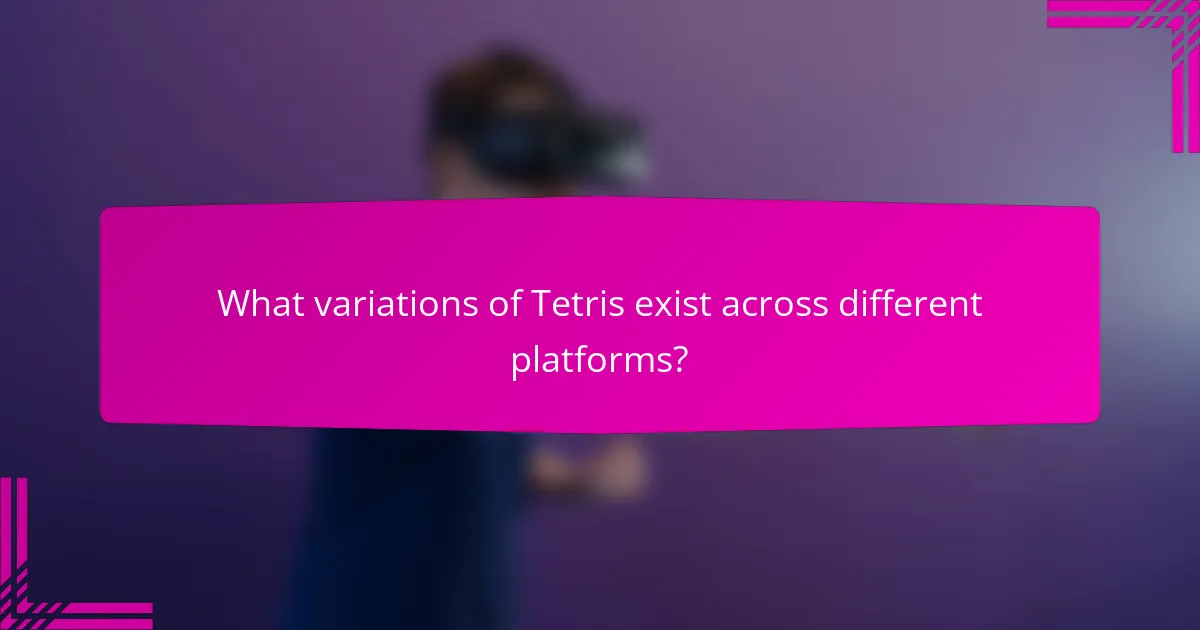
What variations of Tetris exist across different platforms?
Numerous Tetris variations exist across platforms, each offering unique gameplay experiences. Key versions include Tetris Effect, which emphasises visuals and music, and Tetris 99, a battle royale format. Other notable variations are Tetris Blitz, featuring power-ups, and Classic Tetris, which preserves the original mechanics. Mobile adaptations often include simplified controls and touchscreen interfaces, while console versions may focus on multiplayer experiences. Each variation enhances the core mechanics while appealing to different player preferences.
How do mobile versions of Tetris differ from console versions?
Mobile versions of Tetris focus on touch controls and quick gameplay, while console versions utilise physical buttons and often feature more complex mechanics. Mobile adaptations prioritise accessibility and shorter sessions, appealing to casual players. Console versions typically offer richer graphics and multiplayer options, enhancing the competitive experience. Additionally, mobile versions may include unique power-ups or modes not present in traditional console gameplay.
What unique features are present in competitive Tetris formats?
Competitive Tetris formats feature unique mechanics that enhance gameplay and strategy. These include speed variations, piece generation randomness, and unique scoring systems.
1. Speed variations introduce different levels of difficulty, impacting player reaction times.
2. Randomised piece generation alters strategy, requiring adaptability in gameplay.
3. Scoring systems may award bonus points for combos or speed, encouraging aggressive play.
4. Some formats utilise time limits, creating urgency and strategic depth.
5. Unique power-ups or modifiers can change piece behaviour, adding unexpected dynamics.
6. Community-driven rules often emerge, fostering innovation and diverse competitive experiences.

How has Tetris influenced gaming culture?
Tetris has profoundly influenced gaming culture by introducing innovative mechanics and fostering competitive play. Its simple yet challenging gameplay mechanics encourage strategic thinking and quick reflexes. The game’s iconic blocks, known as Tetriminos, have inspired countless variations and adaptations across genres. Tetris also popularised high-score competitions, leading to the rise of esports and online leaderboards. This cultural impact is evident in various media, from art to music, showcasing Tetris as a timeless symbol of gaming innovation.
What are notable Tetris tournaments and events worldwide?
Notable Tetris tournaments and events worldwide include the Classic Tetris World Championship, the Tetris World Championships, and the Tetris 99 Grand Prix. These events showcase top players and feature various formats, emphasising both competitive skill and cultural significance. The Classic Tetris World Championship highlights retro gameplay, while Tetris 99 introduces battle royale elements, attracting diverse audiences. Each event contributes to Tetris’s ongoing legacy in gaming culture.
How has Tetris been represented in art and media?
Tetris has been represented in art and media through various adaptations and cultural references. The game’s iconic blocks have inspired visual artists, musicians, and filmmakers. For example, the Tetris theme has been remixed in numerous musical compositions, showcasing its cultural impact. Additionally, Tetris has appeared in films and television, often symbolising strategy and problem-solving. Its influence extends to contemporary art installations that explore themes of geometry and spatial awareness. The unique attribute of Tetris is its ability to engage players in a meditative experience, often reflected in artistic interpretations.

What psychological effects does playing Tetris have on players?
Playing Tetris can enhance cognitive function, improve mood, and reduce stress. Research indicates that players experience increased spatial awareness and improved problem-solving skills. The game’s fast-paced nature promotes quick decision-making, leading to a sense of accomplishment. Additionally, Tetris can serve as a form of distraction from negative thoughts, providing emotional relief.
How does Tetris impact cognitive skills and problem-solving?
Tetris enhances cognitive skills and problem-solving by improving spatial awareness and strategic thinking. The game’s mechanics require players to visualise shapes, anticipate movements, and make quick decisions. Research indicates that regular Tetris play can increase cognitive flexibility and improve memory. Players develop better problem-solving skills through the need to adapt strategies for different game scenarios. This engagement fosters mental agility and enhances overall cognitive function.
What are the benefits of Tetris in stress relief and relaxation?
Tetris can effectively reduce stress and promote relaxation through its engaging gameplay. The repetitive nature of Tetris encourages focus, allowing players to escape from daily stressors.
Playing Tetris can lead to a state of flow, where players lose track of time and become immersed in the game. This mental engagement can distract from anxiety and improve mood.
Research indicates that playing Tetris may even reduce intrusive memories, helping individuals cope with stressful situations. The game’s strategic elements also promote problem-solving skills, which can enhance resilience in real-life challenges.
Overall, Tetris serves as a simple yet effective tool for stress relief, harnessing the benefits of concentration and cognitive engagement.
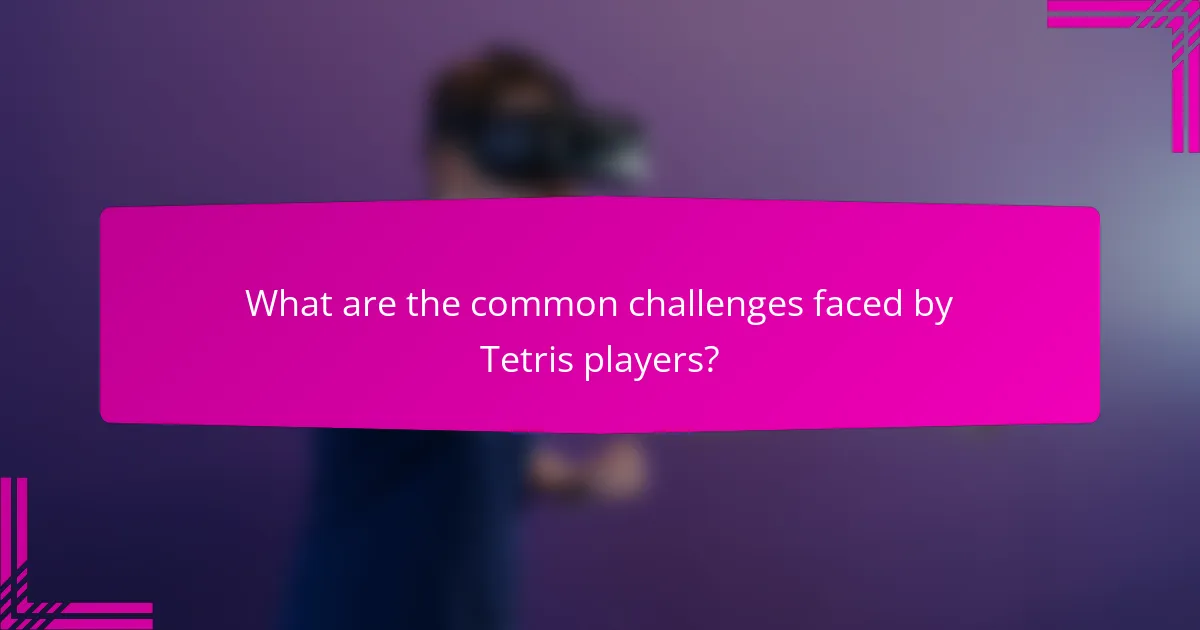
What are the common challenges faced by Tetris players?
Tetris players commonly face challenges such as misplacing blocks, managing speed increases, and dealing with limited visibility. These issues can lead to frustration and game over situations. Players often struggle with spatial awareness, predicting upcoming pieces, and maintaining focus during intense gameplay. Additionally, mastering advanced techniques like T-spins and combos requires practice and strategy.
What are the most frequent mistakes made in Tetris gameplay?
Common mistakes in Tetris gameplay include poor piece placement, failure to anticipate upcoming pieces, neglecting to clear lines strategically, and not utilising the T-spin technique effectively. Players often misjudge the speed of falling blocks, leading to rushed decisions. Additionally, many overlook the importance of maintaining a flat stack for better manoeuvrability.
How can players overcome performance anxiety in competitive settings?
Players can overcome performance anxiety in competitive settings by implementing effective strategies. Focusing on practice and preparation builds confidence, while mindfulness techniques help manage stress. Establishing a routine before gameplay can create a sense of familiarity. Visualising success and setting realistic goals also enhance performance. Engaging in positive self-talk reinforces a winning mindset, reducing anxiety levels.
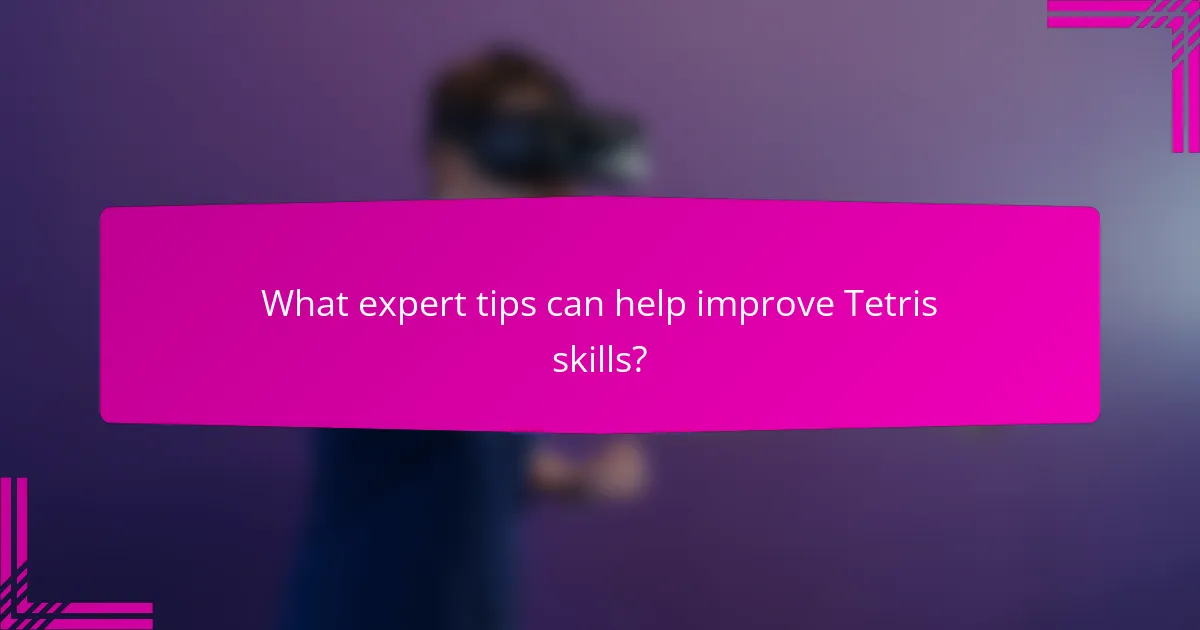
What expert tips can help improve Tetris skills?
To improve Tetris skills, focus on mastering piece rotation, planning ahead, and maintaining a clean stack. Efficiently clear lines and adapt to different game modes.
1. Practice quick rotations to fit pieces into tight spaces.
2. Develop the habit of looking at the next piece to anticipate moves.
3. Keep the stack as low as possible to avoid game-ending situations.
4. Use T-spins strategically to maximise line clears.
5. Experiment with different game variations to enhance adaptability.
How can players practice effectively to enhance their Tetris abilities?
Players can enhance their Tetris abilities through focused practice techniques. Regularly playing various game modes helps develop adaptability. Analysing replays reveals mistakes and areas for improvement. Practising specific skills, such as T-spins and combos, builds proficiency. Engaging with the Tetris community provides insights and strategies for advancement.
What resources are available for learning advanced Tetris strategies?
Numerous resources exist for mastering advanced Tetris strategies. Online platforms like Tetris Friends and Twitch provide gameplay videos and tutorials. Books such as “Tetris: The Games People Play” offer historical insights and strategies. Community forums like Reddit’s r/Tetris facilitate discussion and strategy sharing. Competitive play on platforms like Puyo Nexus enhances skills through practice against others. Lastly, YouTube channels dedicated to Tetris feature expert analysis and advanced techniques.
